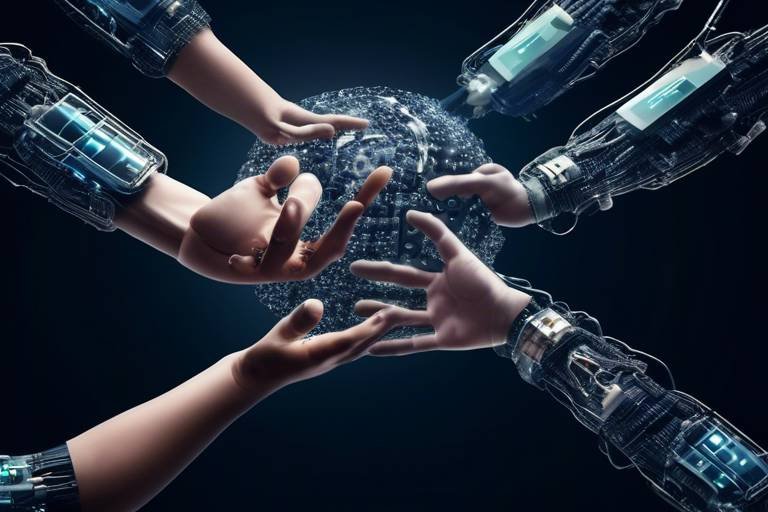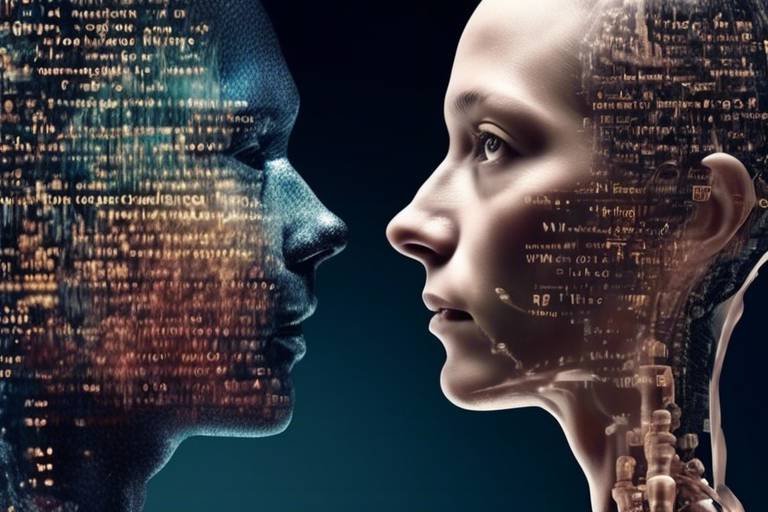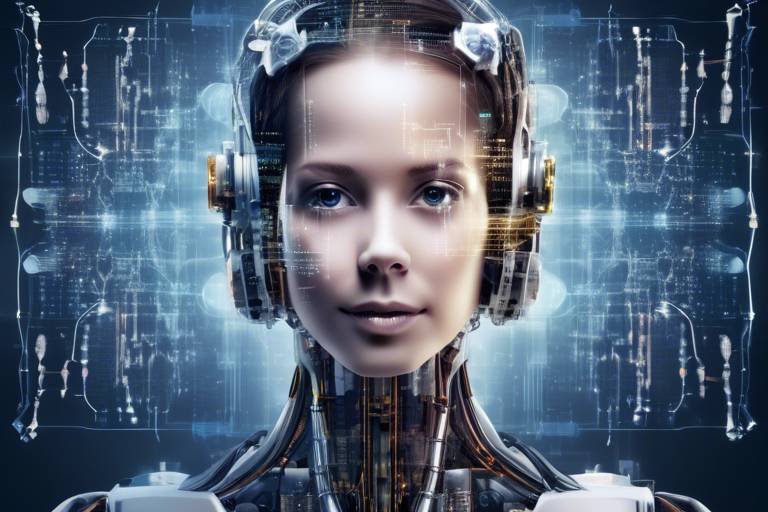Exploring the AI Dynamics in Human Collaborations
In today's fast-paced world, the interplay between artificial intelligence (AI) and human collaboration has become a hot topic. It’s like a dance where both partners must learn to move in sync to create something beautiful. As we delve into this fascinating realm, we uncover how AI not only enhances teamwork but also presents unique challenges. Imagine a scenario where your team is equipped with cutting-edge tools that can predict project timelines, automate mundane tasks, and even suggest creative solutions. Sounds like a dream, right? Yet, as we embrace these advancements, we must also navigate the complexities that come with them. Let’s take a closer look at how AI is reshaping the way we collaborate and what that means for the future.
AI technologies are revolutionizing the way teams communicate and manage tasks. Picture this: a platform that organizes your project, assigns tasks based on team members' strengths, and provides real-time updates. Tools like Slack, Trello, and Asana are just a few examples of how AI can streamline collaboration. These platforms leverage algorithms to enhance productivity, allowing teams to focus on what truly matters—innovation and problem-solving. By automating routine tasks, AI frees up valuable time for brainstorming sessions and creative discussions. Furthermore, AI-driven analytics can help teams identify bottlenecks and optimize workflow, making collaboration not just easier, but more effective.
However, the integration of AI isn’t without its hurdles. While the benefits are clear, teams may face significant challenges. One major concern is resistance to change. When a new system is introduced, especially one as transformative as AI, it can create anxiety among team members. They may fear that AI will replace their roles or disrupt established workflows. To overcome this, organizations must foster an environment that encourages open dialogue about AI's role. Additionally, addressing ethical considerations is crucial. How do we ensure that AI respects privacy and promotes fairness? These are questions that need to be tackled head-on if we want to harness the full potential of AI in our collaborations.
Resistance to change is a natural human reaction. Think about it: when faced with something new, it’s easy to feel apprehensive. This is particularly true in established teams where workflows have been honed over time. To foster acceptance, leaders must adopt strategies that promote adaptability. This could include workshops that educate team members about AI’s benefits, or pilot programs that allow teams to experiment with AI tools in a low-risk environment. By involving team members in the integration process, organizations can transform resistance into enthusiasm.
Effective communication is key to easing fears surrounding AI. Team leaders should create an open forum where employees can voice their concerns. This not only helps in identifying specific worries but also builds trust. When team members feel heard, they are more likely to embrace change. Furthermore, sharing success stories from other organizations that have successfully integrated AI can serve as a powerful motivator. It’s all about painting a picture of a collaborative future where AI enhances, rather than replaces, human ingenuity.
Another critical aspect of successful AI integration is training and development. Providing ongoing education ensures that team members are equipped with the skills needed to work alongside AI technologies. Organizations should invest in training programs that not only cover the technical aspects of AI tools but also emphasize the importance of human skills such as creativity and emotional intelligence. This blend of education creates a workforce that is not only tech-savvy but also capable of leveraging AI to its fullest potential.
As we embrace AI in our collaborative efforts, we must also confront the ethical implications it brings. Questions about data privacy, bias in algorithms, and the potential for job displacement are just a few of the issues that require careful consideration. Establishing ethical guidelines is essential to ensure that AI is used responsibly. Organizations should prioritize transparency and inclusivity, ensuring that all team members understand how AI impacts their work and rights. Only then can we create a collaborative environment that respects and empowers everyone involved.
The future of AI in teamwork is bright, but it requires careful navigation. As technology continues to evolve, so too will the tools we use for collaboration. Emerging trends indicate that AI will play an increasingly significant role in shaping how teams operate. From advanced project management tools to AI-driven decision-making processes, the landscape of collaboration is set to transform dramatically.
New technologies are constantly reshaping the collaborative landscape. Innovations such as virtual reality (VR) and augmented reality (AR) are beginning to merge with AI, creating immersive collaboration experiences. Imagine brainstorming sessions in virtual spaces where team members can interact with 3D models of their projects! These advancements promise to enhance creativity and foster a deeper sense of connection among team members, regardless of their physical location.
To thrive in this evolving landscape, organizations must adopt flexible strategies. This means being open to change and ready to pivot as new technologies emerge. Emphasizing adaptability and foresight will be crucial for navigating the future of AI and teamwork. Leaders should cultivate a culture of continuous learning, encouraging team members to stay updated on the latest trends and tools. By doing so, organizations can ensure that they remain at the forefront of innovation and collaboration.
- What are the main benefits of using AI in teamwork? AI can enhance efficiency, streamline communication, and automate repetitive tasks, allowing teams to focus on creativity and problem-solving.
- How can organizations address resistance to AI integration? Open communication, training, and involving team members in the integration process can help ease fears and promote acceptance.
- What ethical considerations should be taken into account with AI? Organizations should prioritize data privacy, fairness, and transparency to ensure responsible AI use.
- What are some emerging trends in AI and collaboration? Innovations like VR and AR are beginning to transform collaborative practices, creating immersive experiences for teams.

The Role of AI in Enhancing Teamwork
In today's fast-paced work environment, the integration of Artificial Intelligence (AI) into teamwork is not just a trend; it's a necessity. Imagine a world where mundane tasks are handled seamlessly, allowing team members to focus on what truly matters: creativity, strategy, and collaboration. AI technologies are revolutionizing the way teams communicate and manage tasks, transforming the traditional workplace into a dynamic and efficient ecosystem.
AI tools, such as project management software and communication platforms, are designed to streamline workflows. For instance, AI can automate scheduling, prioritize tasks based on urgency, and even provide insights into team performance. This not only saves time but also enhances productivity. Consider a scenario where a project team is juggling multiple deadlines. With AI-powered tools, they can receive real-time updates, manage workloads effectively, and ensure that everyone is on the same page. It’s like having a personal assistant who never sleeps!
Moreover, AI enhances collaboration by leveraging data analytics to inform decision-making. By analyzing past project outcomes, AI can predict potential challenges and suggest optimal strategies for future tasks. This predictive capability allows teams to be proactive rather than reactive, which can significantly improve project outcomes. It’s akin to having a crystal ball that provides insights into the best paths forward.
Here are some key AI tools that are enhancing teamwork:
- Slack: An AI-driven communication platform that helps teams stay connected and organized.
- Trello: A project management tool that uses AI to automate task assignments and track progress.
- Asana: A productivity platform that offers AI features for deadline management and workload balancing.
Furthermore, the integration of AI fosters a culture of innovation within teams. By offloading repetitive tasks to AI, team members can dedicate more time to brainstorming and developing innovative solutions. This shift not only boosts morale but also encourages a collaborative spirit, as team members are more engaged and invested in their projects. Just think about it: when everyone is focused on creative problem-solving rather than administrative duties, the sky's the limit for what teams can achieve!
In conclusion, the role of AI in enhancing teamwork cannot be overstated. By streamlining communication, automating mundane tasks, providing data-driven insights, and fostering a culture of innovation, AI is transforming the collaborative landscape. As we continue to embrace these technologies, teams will be better equipped to tackle challenges and drive success in an increasingly complex world.
- How does AI improve communication within teams? AI tools can facilitate real-time communication and collaboration, ensuring that everyone is informed and aligned.
- What are some examples of AI tools for teamwork? Tools like Slack, Trello, and Asana are popular for enhancing team collaboration and productivity.
- Can AI replace human team members? No, AI is designed to assist and enhance human capabilities, not replace them. It allows team members to focus on more strategic tasks.

Challenges of Integrating AI in Collaboration
Integrating artificial intelligence into collaborative environments is not without its hurdles. While AI can significantly enhance productivity and streamline workflows, it also introduces a set of challenges that teams must navigate. One of the most pressing issues is the resistance to change that often arises when new technologies are introduced. Imagine a well-oiled machine suddenly being asked to incorporate a new part; it can cause friction and hesitation among those who are accustomed to the existing system. Team members may feel threatened by AI, worrying it could replace their roles or diminish their contributions.
Moreover, there are ethical concerns that must be addressed. The more we rely on AI, the more we must consider how it impacts team dynamics and individual rights. For instance, questions surrounding data privacy and the potential for bias in AI algorithms can create unease within a team. It's crucial for organizations to establish clear ethical guidelines that govern the use of AI, ensuring that all team members feel respected and secure in their roles.
Additionally, the need for proper training and support cannot be overstated. Without appropriate educational resources, team members may struggle to adapt to AI tools, leading to frustration and decreased morale. Think of it this way: if you were suddenly handed a complex piece of machinery without any instruction, would you feel confident using it? Probably not. To facilitate a smooth transition, organizations should invest in ongoing training programs that empower employees to embrace AI technologies.
Resistance to change is a natural human reaction, especially when it comes to adopting new technologies. Many team members may view AI as a threat rather than an ally. This psychological barrier can manifest in various ways, such as skepticism, reluctance to engage with new tools, or outright refusal to use them. To overcome this, leaders must foster a culture of openness and encourage dialogue about the benefits of AI. By addressing fears and misconceptions, teams can begin to see AI as a valuable partner in their collaborative efforts.
Effective communication is key to easing fears surrounding AI integration. Leaders should actively listen to team members' concerns and provide clear, transparent information about how AI will be implemented. Holding workshops or Q&A sessions can be beneficial, allowing team members to voice their thoughts and receive reassurance. Creating an environment where questions are welcomed can significantly reduce anxiety and promote a more positive outlook on AI collaboration.
Proper training is essential for successful AI integration. Organizations should prioritize ongoing education and skill development to prepare teams for working alongside AI technologies. This might include hands-on training sessions, online courses, or access to resources that help employees understand how to leverage AI effectively. By investing in their workforce, companies can ensure that team members feel confident and competent in utilizing AI tools, ultimately leading to a more harmonious collaboration.
In summary, while integrating AI into collaboration presents several challenges, addressing resistance to change, ethical concerns, and the need for training can pave the way for a more productive partnership between humans and machines. The road may be rocky, but with the right strategies in place, teams can navigate these challenges and emerge stronger on the other side.
- What are the main challenges of integrating AI in collaboration?
The main challenges include resistance to change, ethical concerns, and the need for proper training and support.
- How can organizations address resistance to AI?
Organizations can address resistance by fostering open communication, providing reassurance, and involving team members in the AI integration process.
- Why is training important for AI integration?
Training is crucial because it empowers employees to use AI tools effectively, reduces anxiety, and enhances overall team productivity.
- What ethical considerations should be taken into account?
Ethical considerations include data privacy, algorithmic bias, and ensuring that AI enhances rather than diminishes human roles.

Resistance to Change
Introducing artificial intelligence (AI) into established workflows can be akin to trying to fit a square peg into a round hole. Many team members may feel a sense of apprehension when faced with the idea of integrating AI into their daily tasks. This resistance often stems from a variety of psychological barriers, including fear of the unknown, concerns about job security, and a general discomfort with new technologies. It’s important to recognize that these feelings are perfectly normal; after all, change can be daunting. Just think about how you might feel if you were asked to switch from your favorite coffee to a new, unfamiliar brew. The initial hesitation is understandable.
To effectively combat this resistance, organizations must adopt a proactive approach. Open communication is key. Team leaders should create an environment where questions and concerns can be voiced without fear of judgment. By addressing these issues head-on, leaders can help demystify AI and illustrate its potential benefits. For instance, rather than viewing AI as a threat, team members should be encouraged to see it as a tool that can enhance their capabilities and reduce mundane tasks. This shift in perspective can make a world of difference.
Furthermore, involving team members in the AI integration process can foster a sense of ownership and reduce resistance. When individuals feel like they have a say in how technology is implemented, they are more likely to embrace it. Consider conducting workshops or brainstorming sessions where team members can express their thoughts and contribute ideas. This collaborative approach not only eases fears but also promotes a culture of innovation. After all, who doesn’t want to be part of something groundbreaking?
Ultimately, it’s about creating a supportive atmosphere where team members can learn and adapt at their own pace. Providing resources such as tutorials, FAQs, and one-on-one training sessions can make the transition smoother. Just like learning to ride a bike, practice and patience are essential. With the right support, individuals will gradually become more comfortable with AI, transforming initial skepticism into enthusiastic acceptance.

Addressing Concerns
When it comes to integrating artificial intelligence into team dynamics, it's not uncommon for apprehensions to surface among team members. After all, introducing AI can feel like inviting an unknown guest to a well-established gathering. What will they bring to the table? Will they overshadow the existing members, or will they enhance the overall experience? Addressing these concerns head-on is crucial for a smooth transition into AI-enhanced collaboration.
First and foremost, communication is key. It's essential to engage in open dialogues with team members about what AI is, how it functions, and the benefits it can provide. By demystifying AI, you can alleviate fears and dispel myths that often surround new technologies. For instance, many people worry that AI will replace their jobs; however, it’s vital to frame AI as a tool that complements human skills rather than competes with them. This shift in perspective can foster a more positive outlook on AI integration.
Additionally, it’s important to create an environment where team members feel comfortable voicing their concerns. Establishing regular feedback sessions can provide a platform for individuals to express their thoughts and feelings about AI implementation. This not only empowers team members but also gives management the opportunity to address specific worries in real-time. Consider the following strategies to facilitate these discussions:
- Encourage Questions: Create a culture where asking questions is welcomed. This can help uncover underlying fears that may not be immediately apparent.
- Provide Clear Information: Share resources and information about AI technologies to help team members understand the tools they will be using.
- Highlight Success Stories: Present case studies or examples from other organizations that successfully integrated AI, showcasing the positive outcomes.
Moreover, it's essential to recognize that the transition to AI isn't just about technology; it's also about people. Understanding the emotional impact of introducing AI is crucial. Team members may feel uncertain about their roles or how their work will change. Addressing these emotional concerns with empathy can go a long way in fostering a supportive environment. Leaders should be prepared to listen actively and provide reassurance, emphasizing that AI is here to assist, not to undermine their contributions.
Ultimately, the goal is to create a partnership between humans and AI that enhances productivity and collaboration. By taking the time to address concerns thoughtfully and proactively, organizations can pave the way for a more harmonious integration of AI into their workflows. This not only helps in easing fears but also builds a stronger, more resilient team ready to embrace the future of work.
Q1: Will AI take my job?
A1: AI is designed to enhance human capabilities, not replace them. It can automate repetitive tasks, allowing you to focus on more strategic and creative aspects of your job.
Q2: How can I learn more about AI?
A2: There are numerous online courses, webinars, and resources available that can help you understand AI and its applications in your field.
Q3: What if I don’t feel comfortable using AI tools?
A3: It's important to communicate your concerns. Organizations should provide ongoing training and support to help you feel more confident in using AI technologies.

Training and Development
In today's rapidly evolving work environment, proper training is not just beneficial; it's essential for the successful integration of AI into human collaboration. Imagine stepping into a new job and being handed a complex tool without any guidance. Frustrating, right? That's exactly how team members feel when they are introduced to AI technologies without adequate training. They may find themselves overwhelmed and unsure of how to leverage these powerful tools effectively. Thus, organizations must prioritize ongoing education and skill development to ensure that their teams are not just familiar with AI but are also confident in using it.
When we talk about training, it’s crucial to adopt a multi-faceted approach. This can include hands-on workshops, online courses, and mentorship programs. For instance, a company might implement a structured training program that covers the following:
| Training Method | Description |
|---|---|
| Workshops | Interactive sessions where teams can engage with AI tools and learn through practical application. |
| Online Courses | Flexible learning options that allow team members to learn at their own pace, covering AI fundamentals and advanced techniques. |
| Mentorship Programs | Pairing experienced employees with newcomers to provide guidance and support in navigating AI tools. |
Moreover, fostering a culture of continuous learning is vital. Organizations should encourage team members to seek out new knowledge and share insights with one another. This could be as simple as creating a knowledge-sharing platform where employees can post articles, tutorials, or even their own experiences with AI in their daily tasks. By doing so, teams not only enhance their skills but also build a sense of community and collaboration.
Lastly, feedback mechanisms should be established to assess the effectiveness of training programs. Regular check-ins and surveys can help organizations understand what works and what doesn’t, allowing them to refine their training approaches continually. After all, the goal is to create a workforce that feels empowered and equipped to harness the full potential of AI in their collaborative efforts. In this way, training and development become not just a checkbox on a to-do list, but a transformative journey that prepares teams for the future.
- What is the importance of training in AI integration? Training helps team members feel comfortable and proficient in using AI tools, leading to increased productivity and collaboration.
- How can organizations implement effective training programs? By using a combination of workshops, online courses, and mentorship opportunities tailored to the needs of the team.
- What role does feedback play in training? Feedback allows organizations to evaluate the effectiveness of their training programs and make necessary adjustments for improvement.

Ethical Considerations in AI Collaboration
As we delve deeper into the realm of artificial intelligence and its integration into human collaboration, we must pause to consider the ethical implications that accompany this technological evolution. The advent of AI in teamwork isn't merely about enhancing productivity; it also raises significant questions about responsibility, transparency, and the rights of individuals involved. The potential for AI to influence decision-making processes can lead to scenarios where accountability becomes murky. Who is responsible when an AI system makes a mistake? Is it the developers, the users, or the AI itself?
Moreover, the data that fuels AI systems often comes from human interactions, which raises concerns about privacy and consent. Teams must ensure that they are not inadvertently infringing on the rights of individuals by utilizing AI tools that analyze personal data without proper permissions. This brings us to the need for ethical guidelines that govern the use of AI in collaborative settings. These guidelines should address issues such as:
- Data Privacy: Ensuring that personal information is protected and used responsibly.
- Transparency: Making AI systems' operations understandable to users.
- Fairness: Preventing biases in AI algorithms that could impact team dynamics.
- Accountability: Establishing clear responsibilities for AI-driven decisions.
Creating a framework for these ethical considerations is crucial for fostering an environment where AI can be embraced without fear. Organizations should engage in open discussions about the implications of AI, allowing team members to voice their concerns and suggestions. By prioritizing ethical practices, companies can build trust among their teams, paving the way for a more harmonious integration of AI technologies.
In addition to ethical guidelines, continuous education and training on the ethical use of AI should be provided. This ensures that all team members are not only aware of the potential risks but are also equipped with the knowledge to navigate these challenges effectively. As AI continues to evolve, so too must our understanding of its ethical landscape. It’s not just about making processes more efficient; it’s about doing so in a manner that respects and upholds the dignity of every individual involved.
In conclusion, the ethical considerations in AI collaboration are not just an afterthought; they are fundamental to the successful integration of these technologies into our workplaces. By addressing these concerns head-on, organizations can ensure that their AI systems enhance collaboration while safeguarding the rights and well-being of all team members.
Q1: What are the main ethical concerns regarding AI in collaboration?
A1: The primary ethical concerns include data privacy, transparency in AI processes, fairness in decision-making, and accountability for AI-driven outcomes.
Q2: How can organizations ensure ethical AI practices?
A2: Organizations can establish clear ethical guidelines, engage in open discussions about AI implications, and provide continuous training on ethical AI use.
Q3: Why is transparency important in AI collaboration?
A3: Transparency helps users understand how AI systems operate, which builds trust and allows for informed decision-making within teams.
Q4: What role does training play in ethical AI collaboration?
A4: Training equips team members with the knowledge to recognize ethical issues and navigate the complexities of working alongside AI technologies.

The Future of AI and Human Collaboration
The future of AI and human collaboration is not just a fleeting trend; it’s a profound transformation that is reshaping the way we work together. Imagine a world where artificial intelligence doesn't just assist us but actually enhances our collective intelligence. This partnership is set to evolve in ways we can only begin to comprehend. As we stand on the brink of this exciting frontier, it’s essential to explore the emerging trends and prepare for the changes that lie ahead.
One of the most significant trends is the rise of collaborative AI systems. These systems are designed to work alongside humans, learning from their interactions and adapting to their needs. For instance, AI-driven platforms can analyze team dynamics and suggest optimal workflows, making the entire process more fluid and efficient. This means that teams can focus more on creativity and less on mundane tasks, allowing for a more innovative work environment.
Moreover, as remote work becomes more commonplace, AI tools are evolving to support distributed teams. With features like real-time language translation, intelligent scheduling, and automated meeting summaries, AI is breaking down barriers that once hindered collaboration. It’s like having a personal assistant who not only understands your needs but also anticipates them, making teamwork feel seamless, no matter where you are in the world.
However, with these advancements come the need for organizations to adopt flexible strategies. As the landscape of work continues to change, it’s crucial for teams to remain adaptable. Companies must invest in training programs that not only teach employees how to use these AI tools but also foster a culture of continuous learning. After all, the more skilled and knowledgeable a team is, the better they can leverage AI to enhance collaboration.
To prepare for this future, organizations should consider the following approaches:
- Invest in Training: Ongoing education will empower employees to navigate new technologies confidently.
- Encourage Open Communication: Creating an environment where team members can voice their concerns about AI integration will help ease transitions.
- Embrace Flexibility: Being open to changing workflows and processes will enable teams to adapt quickly to new AI tools.
As we look ahead, it’s clear that the partnership between AI and humans is just beginning. The potential for innovation is immense, and as technology continues to advance, we can expect even more sophisticated tools to emerge. These tools will not only enhance productivity but also foster a more inclusive and collaborative work culture. The future is bright, and with the right strategies in place, teams can thrive in this new era of collaboration.
- What role will AI play in future collaborations?
AI will enhance communication, streamline workflows, and provide real-time insights to improve teamwork. - How can organizations prepare for AI integration?
By investing in training, fostering open communication, and embracing flexibility in workflows. - Will AI replace human jobs in collaborative settings?
No, AI is designed to assist and enhance human capabilities, not replace them.

Emerging Trends
As we venture deeper into the age of technology, the landscape of teamwork is undergoing a radical transformation, driven primarily by the advancements in artificial intelligence. These changes are not just mere upgrades; they represent a fundamental shift in how we collaborate, communicate, and achieve common goals. One of the most exciting is the rise of AI-powered collaboration tools that facilitate seamless interaction among team members, regardless of their physical locations. Imagine a virtual workspace where AI not only organizes your tasks but also predicts potential roadblocks and suggests solutions before they even arise. Sounds futuristic, right? Well, it’s happening now!
Another significant trend is the increasing use of natural language processing (NLP) in communication platforms. NLP allows AI to understand and interpret human language more effectively, which means that tools like chatbots and virtual assistants are becoming more intuitive. They can engage in meaningful conversations, answer questions, and even provide real-time feedback on projects. This capability is revolutionizing how teams interact, making communication more efficient and less prone to misunderstandings.
Moreover, collaborative AI is emerging as a key player in decision-making processes. By analyzing vast amounts of data, AI can provide insights that help teams make informed choices. For instance, in product development, AI can analyze market trends and customer feedback to suggest features that would resonate with users. This data-driven approach not only enhances the quality of decisions but also fosters a culture of innovation within teams. It's like having a super-smart colleague who always has your back!
However, with these advancements come new challenges. As AI tools become more integrated into our workflows, teams must also navigate the complexities of data privacy and security. Organizations need to establish clear guidelines and practices to protect sensitive information while still reaping the benefits of AI. This balance is crucial for maintaining trust within teams and ensuring that AI enhances rather than hinders collaboration.
In addition to these trends, we are also witnessing an increase in remote collaboration technologies. As remote work becomes the norm, AI tools are evolving to support distributed teams. Features like virtual brainstorming sessions, AI-driven project management, and real-time collaboration platforms are becoming essential for teams looking to maintain productivity and creativity, no matter where they are located. The future of teamwork is not just about working together; it’s about working smarter, leveraging AI to enhance every aspect of collaboration.
As we look ahead, it’s clear that the synergy between AI and human collaboration is set to grow stronger. Organizations that embrace these emerging trends will not only enhance their operational efficiency but also cultivate a more engaged and innovative workforce. The question is, are you ready to embrace the future of teamwork?
- What are AI-powered collaboration tools? These are software applications that utilize artificial intelligence to enhance teamwork by improving communication, task management, and decision-making processes.
- How does natural language processing improve team communication? NLP allows AI to understand and respond to human language more effectively, making tools like chatbots and virtual assistants more intuitive and user-friendly.
- What are the challenges of integrating AI into teamwork? Some challenges include data privacy concerns, the need for proper training, and the potential resistance from team members who may be hesitant to adopt new technologies.
- How can organizations prepare for the future of AI in collaboration? Organizations can prepare by investing in training, adopting flexible strategies, and staying informed about emerging technologies that can enhance teamwork.

Preparing for the Future
As we stand on the brink of a technological revolution, the need for organizations to prepare for the future of collaboration has never been more critical. The landscape of teamwork is rapidly changing, and with the integration of AI technologies, traditional methods may no longer suffice. Organizations must not only embrace these changes but also anticipate them, ensuring that their teams are equipped with the skills and knowledge necessary to thrive in an AI-enhanced environment.
One of the most effective ways to prepare for this future is by adopting a culture of flexibility and adaptability. This means fostering an environment where team members are encouraged to experiment with new tools and technologies without the fear of failure. Just like a surfer riding the waves, organizations need to learn how to navigate the ebbs and flows of technological advancements. This involves not only understanding the tools at their disposal but also recognizing when to pivot and adapt strategies based on emerging trends.
Moreover, ongoing education and training play a pivotal role in this preparation. Companies should invest in training programs that focus on both technical skills related to AI and soft skills that promote effective collaboration. For instance, workshops that teach team members how to leverage AI tools for project management can significantly enhance productivity. Here are a few key areas organizations should focus on:
- Technical Proficiency: Ensure team members are comfortable using AI tools and platforms.
- Collaboration Skills: Promote communication and teamwork strategies that complement AI technologies.
- Adaptability Training: Encourage a mindset that embraces change and innovation.
Additionally, organizations should cultivate a sense of trust and transparency within teams. As AI systems become more integrated into daily workflows, team members may feel apprehensive about their roles and the implications of AI decision-making. By fostering open communication and addressing concerns, leaders can help alleviate fears and build trust in the collaborative process. It's essential to create a space where team members feel comfortable voicing their opinions and asking questions about AI integration.
Lastly, organizations need to stay informed about the latest trends in AI and collaboration. This means keeping a pulse on industry developments and being proactive in adapting to changes. By attending conferences, participating in webinars, and engaging with thought leaders in the field, organizations can gain valuable insights that will help them remain competitive. The future of AI collaboration is not just about adopting new technologies; it’s about creating a culture that embraces innovation and prepares for the unknown.
In summary, preparing for the future of AI and human collaboration requires a multifaceted approach that includes flexibility, ongoing education, building trust, and staying informed. By taking these steps, organizations can ensure that they are not just surviving in the age of AI but thriving alongside it.
Q1: What is the most important factor in preparing for AI integration?
A1: Flexibility and adaptability are crucial. Organizations must foster a culture that embraces change and encourages team members to experiment with new technologies.
Q2: How can we ensure team members are comfortable with AI tools?
A2: Providing ongoing education and training focused on both technical and soft skills will help team members become proficient and confident in using AI tools.
Q3: What role does communication play in AI collaboration?
A3: Effective communication is essential for building trust and addressing concerns among team members regarding AI integration.
Q4: How can organizations stay updated on AI trends?
A4: Engaging in industry conferences, webinars, and following thought leaders in AI can help organizations stay informed about the latest developments.
Frequently Asked Questions
-
How does AI enhance teamwork?
AI enhances teamwork by streamlining communication and automating task management. It allows team members to focus on higher-level tasks while AI handles repetitive processes, making collaboration smoother and more efficient. Think of AI as a helpful assistant that organizes your schedule and reminds you of deadlines, so you can concentrate on what truly matters.
-
What challenges might teams face when integrating AI?
Integrating AI can lead to several challenges, including resistance to change among team members, ethical concerns regarding data privacy, and the need for proper training. Some team members might feel threatened by AI, fearing it could replace their jobs. It's crucial to address these fears with open communication and support.
-
How can teams overcome resistance to AI?
To overcome resistance, it's essential to foster a culture of openness and adaptability. Engage team members in discussions about AI's benefits, provide clear examples of how it can assist rather than replace them, and involve them in the implementation process. This way, they can see AI as a partner rather than a competitor.
-
What role does training play in AI integration?
Training is vital for successful AI integration. Ongoing education helps team members understand how to use AI tools effectively, ensuring they feel confident and capable. Think of it as learning to ride a bike; with the right guidance and practice, it becomes second nature.
-
Are there ethical concerns with AI in collaboration?
Yes, ethical concerns are significant when it comes to AI in collaboration. Issues such as data privacy, bias in AI algorithms, and the potential for surveillance need to be addressed. Establishing clear ethical guidelines can help ensure that AI is used responsibly and that team members' rights are protected.
-
What are the emerging trends in AI and teamwork?
Emerging trends include the development of more intuitive AI tools that enhance real-time collaboration, as well as the rise of remote teamwork technologies. These innovations are reshaping how teams interact, making it easier to work together regardless of location, much like having a virtual office at your fingertips.
-
How can organizations prepare for the future of AI in collaboration?
Organizations can prepare by adopting flexible strategies that allow for quick adaptation to new technologies. Emphasizing continuous learning and encouraging a growth mindset within teams can help everyone stay ahead of the curve, ensuring they are ready for whatever the future holds.



















